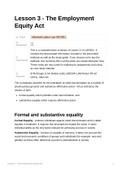Lesson 3 - The Employment
Equity Act
Class Individual Labour Law IOP2601
Reviewed
This is a comprehensive summary of Lesson 3 in LLW2601. It
includes the demarcated information included in the prescribed
textbook as well as the study guide. If you choose not to buy the
Comments textbook, this summary fills in all the parts you would otherwise miss.
These notes are very useful in studying for assignments and using
as core study material.
M McGregor & AH Dekker (eds) LABOUR LAW Rules! 4th ed
Sources (2021), Siber Ink
The Constitution provides for the prohibition of unfair discrimination on a number of
(inexhaustive) grounds and authorizes affirmative action. It thus embraces the
notions of both:
formal equality which prohibits unfair discrimination, and
substantive equality which requires affirmative action.
Formal and substantive equality
Formal Equality - protects individuals against unfair discrimination and is called
equality in treatment. It requires that all people be treated the same. It views
individual ability as the only factor relevant for achieving success in society
Substantive Equality - focuses on equality of outcome. It takes into account the
social and economic conditions of groups and individuals (for example, race and
gender) as these often determine a person’s place/position in society
Lesson 3 - The Employment Equity Act 1
, Differentiation and discrimination
Discrimination is differentiation based on illegitimate grounds.
As to what would constitute illegitimate grounds, there are three possibilities. There
are the so-called:
specified/listed grounds such as race, sex, religion and pregnancy;
unspecified/ unlisted grounds; and
arbitrary grounds
Direct and indirect discrimination
Direct discrimination - occurs where a person is overtly treated differently because
of, for example, his or her race. Usually, direct discrimination is easy to recognize.
Indirect discrimination - occurs when criteria or policies which appear to be
neutral, are applied but then unjustifiably affect a disproportionate number of a
group, for example, because of their sex. Indirect discrimination is often disguised
and difficult to detect.
Specified, unspecified grounds and
arbitrary grounds of discrimination
Section 6(1) of the EEA provides a non-exhaustive list of 19 grounds on which
discrimination is prohibited in both policies and practices.
They are race, gender, sex, pregnancy, marital status, family responsibility,
ethnic or social origin, color, sexual orientation, age, disability, religion, HIV
status, conscience, belief, political opinion, culture, language and birth or any
other arbitrary ground.
It is important to note that the grounds of discrimination in the EEA have been
amended to include arbitrary grounds.
Lesson 3 - The Employment Equity Act 2





